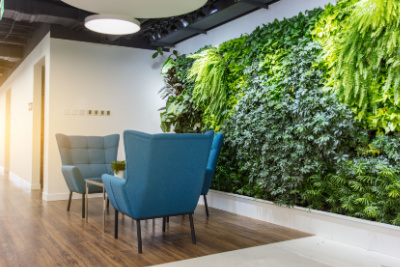As more employees return to the office in a hybrid or fully in-office setting, it’s important for facilities professionals to work with building management on de-stressing the workplace by implementing biophilic design principles, which involves the use of nature in facility designs.

During Facilities Management Advisor’s Healthy Buildings Week 2023, guest speaker Kelly Walowski, global design consultant from session sponsor Ambius, gave a presentation on August 16 titled “Designing Healthy Spaces with Biophilic Design.”
Why Is Biophilic Design Important?
Many enjoy vacationing in the mountains, in the woods, at the lake, or on a beach along the ocean, as it helps them feel a sense of peace. This need to connect with nature is called biophilia.
According to Walowski, using biophilic designs in facilities allows people to communicate better, process things better, have improved physical and mental health, and sleep better, as well as reduces absenteeism and presenteeism, which could be dangerous if employees come to the workplace when sick and don’t want to take time off to get better. All of these can contribute to better productivity.
“Research shows that when organizations support the health of their most valuable assets, people, they often experience lower turnover and burnout as well as greater productivity and engagement, driving improvements for their bottom line,” Walowski said.
Biophilic Concepts
There are a variety of ways facilities can be reconfigured to incorporate a biophilic design. Facilities professionals should therefore work with company management to determine which concepts are best for their facilities.
Walowski highlighted nine biophilic concepts that have the biggest impact:
- Vegetation: Add plants of different sizes, varieties, and colors to break up interior spaces.
- Refuge and shelter: Create privacy barriers by using indoor plants in large areas where people gather, such as lobbies.
- Sound: Improve your facility’s acoustics by using foliage and green walls to absorb or block sound.
- Connections with the exterior: Install exterior plantings that are visible from the windows, and plant flowers and trees on the corners of the walls.
- Overlooking a landscape: Create atriums and open up walls to provide natural views or create the illusion of a landscape.
- Natural materials: Use plant- and mineral-based materials like stone, wood, bamboo, rocks, and gravel to provide a more natural feeling.
- Light: Install full-spectrum lighting to smooth the hard edges of facilities, especially around and near windows, to provide better light quality.
- Scents: Add pleasant and natural smells to the main parts of facilities where people typically walk through. Ambius’s “Biophilic Design Trends 2023” report recommends smells like marine, lavender, cucumber, ginger, and bamboo.
- Water: Create a water view, which could be a water feature, artwork, or a pond outside.
Social Distance Design
As COVID hospitalizations continue to increase, facilities professionals and building management must do their part to ensure their facilities are healthy and safe. Because of that, Ambius’s “Biophilic Design Trends 2023” report provides recommendations for facilities that want to incorporate social distancing into their design.
Specifically, Ambius encourages facilities to implement the following features:
- Encourage separation.
- Control traffic flow.
- Establish wayfinding.
- Manage occupancy.
- Increase privacy.
All Facilities Can Benefit
All types of facilities can benefit from biophilic designs, not just offices. During her presentation, Walowski cited Apple’s strategic sourcing manager, Kim Wible, who said that some of their retail stores, most of which are in indoor shopping malls, use ficus trees and natural light to create a grove effect.
“Biophilia improves the air quality and provides an indoor space that is a pleasant and happy environment,” Wible noted.
Learn More
During the webinar, Walowski also explained how buildings directly benefit from biophilic designs and discussed three tools in the biophilic design toolbox, as well as talked about how to make lobbies, coworking spaces, and break areas more inviting.
To watch the entire webinar on demand for FREE, click here. Additionally, be sure to check out all the virtual events and resources as part of Facilities Management Advisor’s Healthy Buildings Week 2023, including “How to Improve Facility Health Through WELL.”
